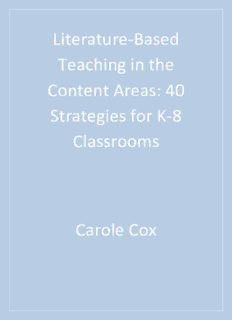
Literature-Based Teaching in the Content Areas: 40 Strategies for K-8 Classrooms PDF
Preview Literature-Based Teaching in the Content Areas: 40 Strategies for K-8 Classrooms
Literature-Based Teaching in the Content Areas: 40 Strategies for K-8 Classrooms Carole Cox Copyright©2012bySAGEPublications,Inc. All rights reserved. No part of this book may be reproduced or utilized in any form or by any means, electronic or mechanical, including photocopying, recording, or by any information storage and retrieval system, without permissioninwritingfromthepublisher. Forinformation: SAGEPublications,Inc. SAGEPublicationsIndiaPvt.Ltd. 2455TellerRoad B1/I1MohanCooperativeIndustrialArea ThousandOaks,California91320 MathuraRoad,NewDelhi110044 E-mail:[email protected] India SAGEPublicationsLtd. SAGEPublicationsAsia-PacificPte.Ltd. 1Oliver’sYard 33PekinStreet#02–01 55CityRoad FarEastSquare LondonEC1Y1SP Singapore048763 UnitedKingdom PrintedintheUnitedStatesofAmerica LibraryofCongressCataloging-in-PublicationData Cox,Carole,1943- Literature-basedteachinginthecontentareas:40strategiesforK–8classrooms/CaroleCox. p.cm. Includesbibliographicalreferencesandindex. ISBN978-1-4129-7493-6(pbk.:alk.paper) 1. Literature—Studyandteaching(Elementary) 2. Literature—Studyandteaching(Middleschool) I. Title. LB1575.C7992012 372.64—dc22 2010034406 Thisbookisprintedonacid-freepaper. 12 13 14 15 16 10 9 8 7 6 5 4 3 2 1 AcquisitionsEditor: DianeMcDaniel EditorialAssistant: TerriAccomazzo ProductionEditor: BelindaThresher CopyEditor: JeniferDill Typesetter: C&MDigitals(P)Ltd. PermissionsEditor: AdeleHutchinson Proofreader: VictoriaReed-Castro Indexer: MichaelFerreira CoverDesigner: JanetKiesel MarketingManager: EricaDeLuca Contents Preface ix Acknowledgments xiii Introduction 1 Part I. Language Arts and Reading 7 What Research Has to SayAbout Literature-BasedTeaching and LanguageArts and Reading 7 Guidelines for Selecting Books forTeaching LanguageArts and Reading 9 National Standards for the English LanguageArts 9 References 11 1 All About Book 13 2 Biopoems 19 3 Book Clubs 25 4 Online Discussion Boards 31 5 Interactive Writing 37 6 Journal Writing 43 7 Poetry Walks 49 8 Performance Reading 57 Part II. Social Studies 65 What Research Has to SayAbout Literature-BasedTeaching and Social Studies 65 Guidelines for Selecting Books forTeaching Social Studies 67 National Standards for Social Studies 67 References 68 9 Curriculum Drama 71 10 Map Making 79 11 Timelines 87 12 Oral History 95 13 Data Charts 101 14 Multiple Perspectives Jigsaw 111 15 WebQuests 119 16 Service-Learning 125 Part III. Mathematics 131 What Research Has to SayAbout Literature-BasedTeaching and Mathematics 131 Guidelines for Selecting Books forTeaching Mathematics 132 National Standards for Mathematics 132 References 134 17 Finding a Fibonacci 135 18 Discovering Pi 141 19 Marvelous Mathematicians 147 20 Math Poetry 155 21 Cubing MathVocabulary 163 22 Math Stories 171 23 Math in the World 179 24 Math Puzzle Journals 185 Part IV. Science 191 What Research Has to SayAbout Literature-BasedTeaching and Science 191 Guidelines for Selecting Books forTeaching Science 193 National Standards for Science 194 References 195 25 Graphic Organizers 197 26 What’s in the Sky? 207 27 Meet the Scientist 213 28 Science Notebooks 221 29 Q&A Reports 231 30 Mystery Matter 239 31 Virtual FieldTrips on the World Wide Web 247 32 Food Diaries 253 PartV.The Arts 261 What Research Has to SayAbout Literature-BasedTeaching and theArts 261 Guidelines for Selecting Books forTeachingTheArts 263 National Standards forArts Education 264 References 265 33 Songwriting 267 34 Music Stories 275 35 Collage 281 36 I Am the Artist 289 37 Dance a Poem 297 38 Dance Improvisation 303 39 Story Dramatization 309 40 Reader’sTheatre 319 Index 325 About theAuthor 333 Preface As the students in my 3rd- and 4th-grade combination class packed up at the end of the day, I watched in dismay as two of them struggled over possession of a paperbackbook,eachonewantingtotakeithome.Eachoneheldontoit,yank- ing it back and forth until they finally ripped it in half. I was stunned. The class was stunned. The two students, each holding half of the book, were stunned. And embar- rassed.Andfeelingguilty.Theystartedtocry.Itookthemoutintothehallsotheycould explain to me in private what had happened. One said “I love that book.” The other one said “No, I love it.” TherippedbookwasSearchforaLivingFossil:TheStoryoftheCoelacanth(Clymer, 1966). In 1938, a strange, 5-foot long, 250 pound fish was discovered off the coast of SouthAfrica.ItwaspreviouslyknownonlyinthefossilrecordoftheCretaceousperiod and was thought to have been extinct for 70 million years. This book told the story for children.Ihadcheckeditoutoftheschoollibraryduringourclass’ssciencestudyofthe behavior of mealworms. While observing, recording information, and reading books about mealworms, I had encouraged my students to read about other living organisms. Thetwostudentswhorippedthebooklovedreadingandre-readingitandtalkingabout it. They began to read other books about marine life and asked if we could have an aquarium in our classroom to observe fish as well as mealworms. As we talked in the hall after the incident, the students made up and agreed to buy a newcopyofthebookwiththeirownmoneytoreplacetherippedone.Wetalkedabout what they had learned about cooperating with other students and respecting school property. I learned something too. This experience brought new meaning to the saying I had heard about how important it is to “Put the right book in the hands of a student”—even if they rip it in half. P B URPOSE OF THE OOK Thesamemightbesaidforputtingtherightbookinthehandsofateacher,abookthat can engage both the students and the teacher, lead to meaningful discussions related to students’ prior experiences and current interests, and become a jumping off place for teaching and learning in the content areas. And indeed, after I left the elementary classroom and earned a PhD in Education, I found this to be true. I taught undergraduate and graduate courses in children’s literature and in language arts and readingmethods.Ilearnedhowpowerfulitisforapreserviceteacherinamethodsclass ix
Description: